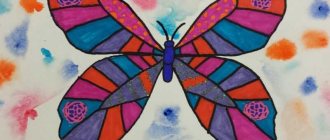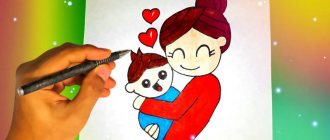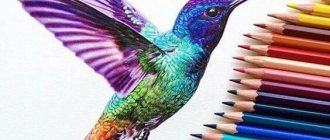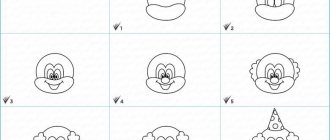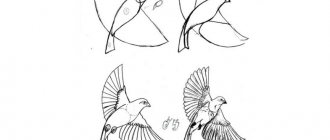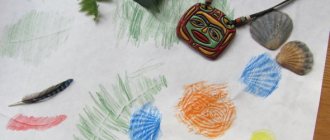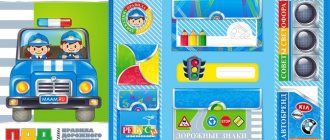Child learns to draw
Through encouraging conversations and modeling from adults, their scribbles are now recognizable to others as “things.” It is also an introduction to the complex and abstract idea that written words are also symbols of meaning.
Our children are beginning to understand the communicative power of their grades.
The next important development is the ability to recognize the “inner” and “outer” of these forms. The dots inside become eyes and noses, the lines shoot out from the outside, becoming arms, legs, sun rays, petals and stems. These same skills are needed to improve writing the letters of the alphabet.
The adults in their lives are excited and this positive feedback is very encouraging to our children. Their drawings are praised and hung on the walls of children's institutions and on the doors of refrigerators. And so they draw and draw.
What's not to like about drawing from the perspective of a four year old? This gives them immense inner pleasure and seems to make their loved ones happy too. Except, obviously, when it's on the bedroom wall, on the carpet, or in Dad's passport.
Notes on drawing “Different houses have been built in the village” (children 5–7 years old)
Lyubov Petrik
Notes on drawing “Different houses have been built in the village” (children 5–7 years old)
Topic of the week: “My village”
GCD topic: “ Different houses have been built in the village ”
.
Educational field: Artistic and aesthetic development.
5-6 years: Teach children to convey the variety of rural houses : tall and long, lower and narrow, one-story. Strengthen the ability to convey the shape of parts of houses. Practice drawing with colored wax crayons.
6-7 years old: Teach children to convey in a drawing a picture of an evening village, color scheme: the houses are lighter than the night air, multi-colored lights . Strengthen the ability to draw up your plan, compositionally arrange the image on the sheet.
Form of organization: frontal, subgroup.
Preliminary work: Excursions along the streets of the village, looking at photographs, illustrations, postcards depicting houses of different types , conversation on the topic: “What kind of house do you live in?”
, reading proverbs and sayings, poems about the homeland,
constructive games .
Integration of educational areas: “Artistic and aesthetic development (music)
",
"Speech development"
, Social and communicative development",
"Physical development"
,
"Cognitive development"
.
Techniques: Surprise and game moments, creating a problem situation, showing and examining illustrations, conversation, artistic expression.
verbal: reminder, questions, individual answers from children, encouragement, lesson analysis;
visual: viewing, viewing;
gaming: didactic game, use of surprise moments, performing game actions.
practical: independent activities of children.
Demonstration material: house , crafts from “House”
.
Handouts: for children 5-6 years old, album sheets, colored wax crayons or colored pencils; for children 6-7 years old, dark paper, watercolor paints, brushes.
Drawing a house
How to draw a house with a pencil and still get a great result?! After this, the child should be taught more complex drawings.
For example, draw a house step by step. It seemed like just a few lines, but if you get more creative, it will be a little more complicated, but more interesting.
And so let's get started, we need:
- Colour pencils,
- A simple soft pencil
- Eraser,
- And one or two more simple soft pencils, in reserve, or shavings - in reserve,
- Album sheets.
- Having prepared everything and taken a comfortable place, you can begin. In this case, you and your child agree in advance:
- You draw one picture together,
- Or you have a competition to see who can draw the best house.
At the same time, take a laptop or tablet with you - this will help you watch a master class for beginners on drawing at home. You will need this if you do not have drawing skills.
Any artist can draw a house exactly the way he likes - a multi-story house, a village house, a castle, etc.
Before starting to draw, ask your child to cover and remember all the small details of the structure. And after he accurately remembers the outline of his beloved house, he can begin to depict it.
- There are several options, or rather based on several geometric shapes. Consider an image based on a diamond.
- Draw a horizontal line and place two points (vanishing points) along the edges of this line. We draw a vertical line that runs across our horizontal line at exactly 90 degrees. We connect each end of the vertical line with the placed points on the horizontal line.
- Add a vertical line on each side relative to the drawn vertical line. Using lines we get the outline of our house. In this case, our house will turn out to be voluminous.
- Next, stepping back from the center of our rhombus, draw a vertical line upward. Then we will draw two inclined lines, one on each side. At this stage we can clearly outline our future roof.
- After that, more clearly draw all the sides and edges we need. After which you can remove the auxiliary lines that were necessary in constructing our drawing of the future house.
- Yes, this option is best used for older children who roughly know what drawing and lines and geometric shapes are.
- Next, we determine the location for the door and windows. We draw a rectangle - this is our future door. Next, we draw our windows, decide for yourself whether there will be one or more of them.
- We draw the windows and door taking into account the vanishing points. Next, you can decorate the house with any additional elements - pipes, shutters, etc. It all depends on you.
Well, here is the last stage. If you decide to leave the house unpainted, it's worth going through and putting on the finishing touches. Well, if you still decide to decorate, then grab colored pencils or paints and make it beautiful. Our house is ready.
Fairytale house
If you don’t want just a sketchy house, then you can always draw a house from a fairy tale. Because there are no rules here, only your imagination. Here are some tips to guide your imagination:
- You can start drawing from the roof, make it slightly curved, asymmetrical.
- Next, we draw the bottom so that it matches the roof and does not go beyond its boundaries.
- Then we draw windows, you can make them of absolutely any shape, doors.
- Add a few details, for example, a lawn, a path, flowers, firewood, whatever you like.
- Decorate with bright colors.
- The house is ready.
Drawing such buildings is perfect for stimulating the imagination and relieving the head of unnecessary thoughts.
Or you can also draw a house like this
Well, now let’s look at the simplest drawing technique that a preschooler can draw. How to draw a house easily with your child. And so we need everything the same as in the first version for adults.
Let's start drawing according to step-by-step instructions for children:
- On a landscape sheet we draw a simple square,
- On top of the square we draw a triangle, which symbolizes the roof of our house,
- This drawing is in our projection, so we add additional walls, the house is ready,
- We connect all the sides we need for a three-dimensional house with a simple pencil,
- We draw the lines at approximately an angle of 15-20 degrees, the length of your house depends on this,
- We draw exactly the same straight line from the roof,
- This is how we got the house in projection,
- We add windows, doors, pipes, ebbs and other elements necessary for a realistic drawing,
- The drawing can be decorated, or left in a simple pencil,
- If desired, you can complete the composition: add trees, flowers, a fence, people, animals. In this case, the yard will be a full cup. It would be nice if your child drew himself and his parents.
At the same time, make sure that your child combines colors correctly. And don’t forget to pay attention to the use of colors in your child’s drawings. This will help monitor your child's psychological state.
Drawing classes help in the development of your child, both psychological and mental development.
Constant exercise will only improve your communication and the child’s condition.
Baba Yaga's hut
Baba Yaga's hut is also considered a house, which can also be drawn. It does not require a ruler; all you need to do is draw all the elements by hand:
- Draw a pentagon-trapezoid, this will be the roof and the hut itself at the same time;
- Now you need to draw a window on the wall, you can add a hole in the attic. Frame the roof with edging;
- Logs are painted on the sides of the walls, shutter frames are added to the window;
- A pipe is painted on the roof, you can also draw horizontal lines to create the full impression of a log hut;
- All that remains is to draw the chicken legs below. You can add other landscape elements.
Baba Yaga's hut is drawn.
If you have the desire and opportunity, it is better to paint it.
Photos of drawings of houses
0
